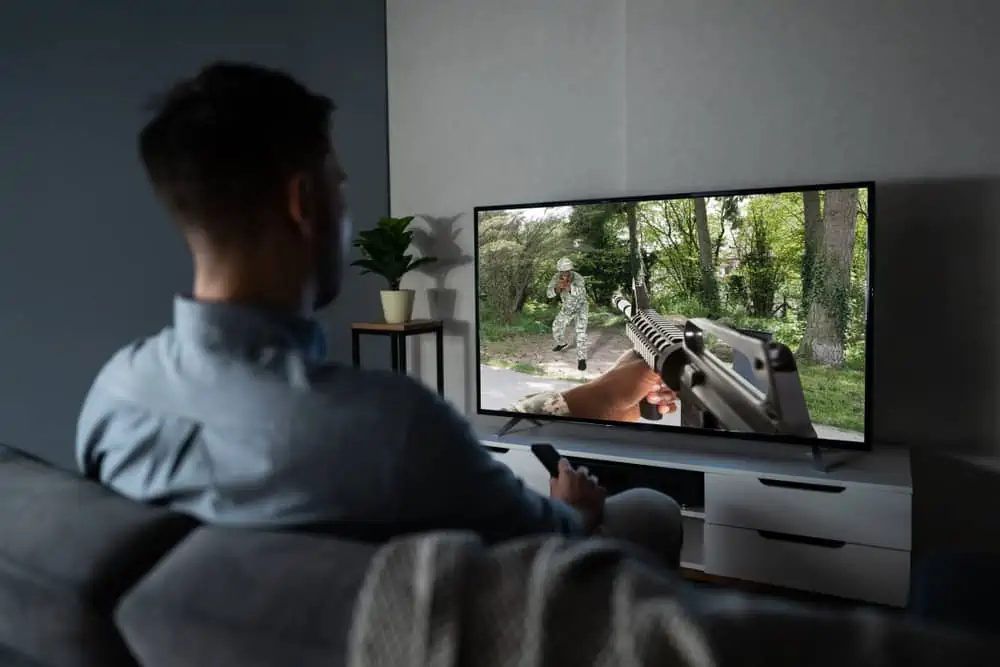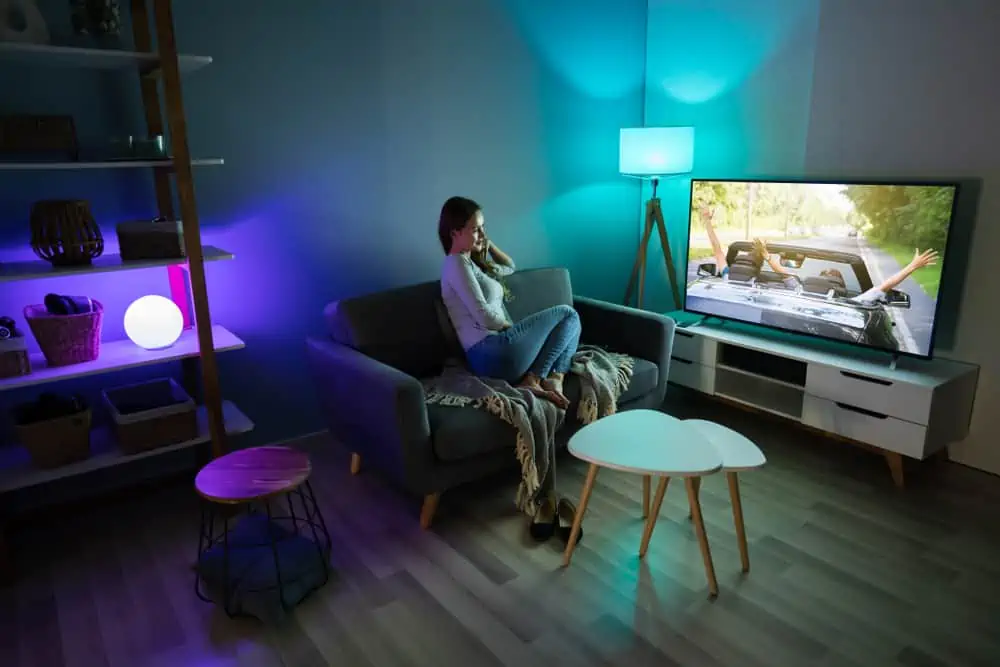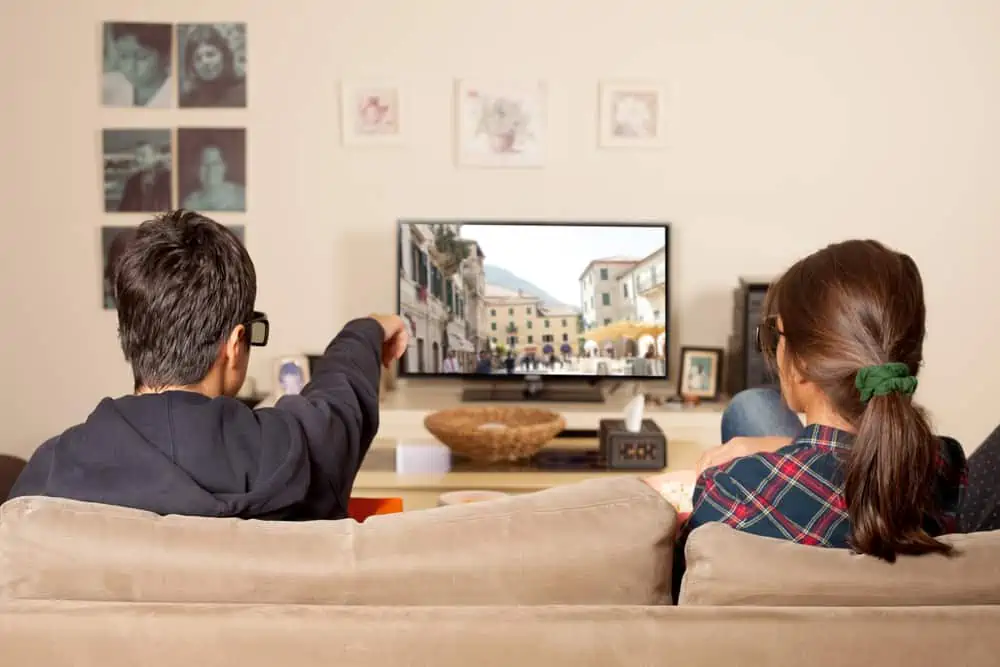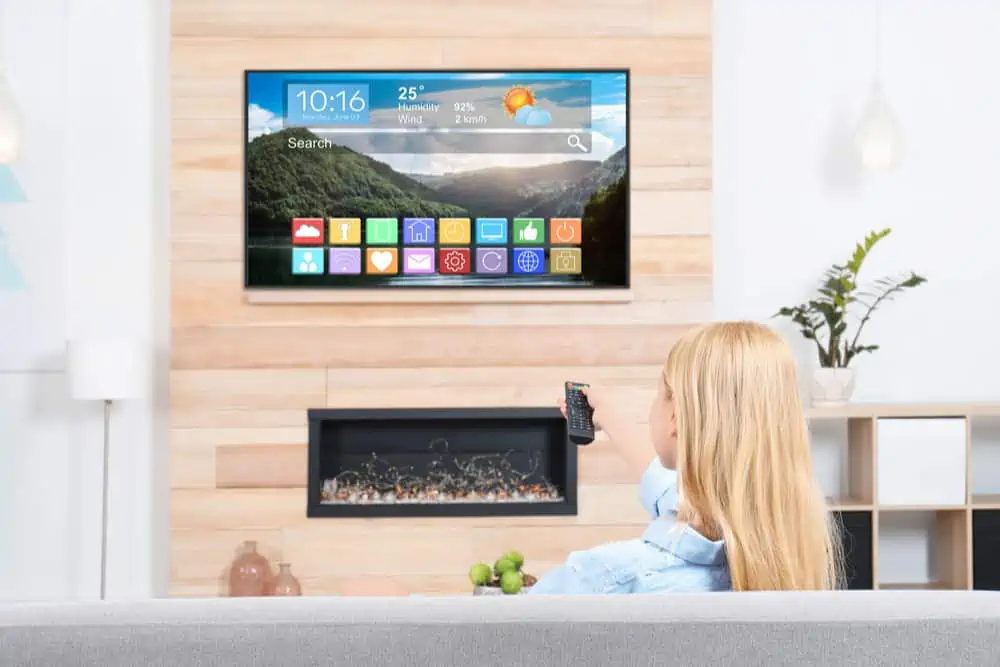Hisense R6 Series: At First Glance
The Hisense R6 Series is a smart television that offers a mixture of value and affordability. For a price tag of $309, this television offers an adequate 4K display with good picture quality and the Roku OS.
It is important to mention that this price tag was valid as of the time I published this review in May 2022. However, as most of us know, televisions with such an inexpensive price tag come with a few trade-offs.
As expected, the Hisense R6 Series isn’t an exception. Now the question is, do the television’s trade-offs outweigh its good features?
How about you continue reading to find out?
Hisense R6 Series: Design, Dimension, and Weight
The Hisense R6 Series comes with a basic design that one would expect from a budget-friendly television. To give more details, the front view of the television features slim bezels that surround the display.
Although the bottom bezel is slightly thicker than the others, it features a “Hisense” logo at the center. Besides, these bezels are made of plastic and feature a matte-black finish.
Moving on, the Hisense R6 Series comes with two plastic legs with a matte-black finish. These legs are positioned very close to the edges of the television.
Hence, you will need a fairly large table or desk to place the television on to prevent it from falling off. Impressively, despite the legs being made of plastic, they are somewhat sturdy and prevent the television from wobbling too much.
That said, looking at the rear, the Hisense R6 Series comes with a plastic rear panel that features a matte-black finish. This rear panel is significantly slim except for the bottom part that houses the television’s electronics and components.
Moreover, the rear panel has four VESA 200 x 300 holes that allow users to wall-mount the television. However, because of the thick bottom part of the rear panel, the Hisense R6 Series will bulge out when wall-mounted.
To make situations more complicated, the television’s rear panel lacks any form of a cable management system. Thus, you will have to manually arrange the cables attached to the television to ensure a neat setup.
Having said all that, let us move on to discuss the dimensions and weight of the television. The Hisense R6 Series measures 1231.9 x 73.6 x 711.2 mm (W x D x H) and weighs 11294.4 g.
Honestly, for a 55-inch television, this Hisense television isn’t too heavy. As a matter of fact, compared to most of its competitors, the television is significantly light.
For example, the LG 55UM7300PUA weighs 14016 g and measures 1244.6 x 86.3 x 726.4 mm (W x D x H).
In summary, the Hisense R6 Series features a decent design with slim bezels and sturdy legs. However, the bottom part of the television’s back panel is thick and lacks a cable management system.
As a result, I will rate the Hisense R6 Series an eight out of ten in this design review section.
Hisense R6 Series: Display Features and Picture Quality
Starting off, the Hisense R6 Series features a 55-inch LCD display with 4K UHD (3840 x 2160) resolution. Due to this 4K UHD resolution, this television’s display should be able to render clear, sharp, and colorful picture quality.
Apart from the 4K UHD resolution, the Hisense R6 Series’ display also has a high contrast ratio. For your information, contrast ratio refers to the proportion between the deepest black and brightest white of a display.
Furthermore, a high contrast ratio means a display will be able to render deep and rich blacks. Thus, with a contrast ratio as high as 5,408:1, the Hisense R6 Series’ display should be able to render deep blacks.
Moreover, a high contrast ratio is important when watching content with lots of dark scenes, as blacks will appear rich/deep. However, when watching such content on the Hisense R6 Series in a dark room, blacks may appear a bit grayish.
The reason is that the Hisense R6 Series lacks a local dimming feature even though its display’s backlighting is direct-lit. For better understanding, direct-lit backlighting means that there are LED diodes all across the back of the television’s LCD display panel.
These LED diodes evenly distribute light across the LCD panel, allowing the display to produce bright images. So, the function of a local dimming feature is to dim the LED diodes when the display is rendering dark scenes.
Thereby making black highlights in dark scenes appear deeper, richer, and sharper. Unfortunately, because the Hisense R6 Series lacks a local dimming feature, you won’t experience such.
As if the lack of local dimming was not enough, the Hisense R6 Series isn’t bright enough. To be more specific, the television’s display recorded a maximum brightness of 231 nits.
This maximum brightness is way below the standard category average of 650 nits. As a result, using the Hisense R6 Series in well-lit areas or outdoors might prove problematic.
On a positive note, the Hisense R6 Series has a decent reflection handling performance. This is because its display features a semi-gloss finish that helps to diffuse reflection and sun glares.
However, for an effective reflection handling performance, I suggest you use the television in moderately-lit rooms.
Proceeding to the viewing angles, you should know that the Hisense R6 Series is VA television. Basically, its display is made with a VA (Vertical Alignment) panel.
Hence, as with most VA panel televisions, this television’s display offers poor viewing angles. Due to this, the Hisense R6 Series isn’t good for a large room setting.
This is because when watching the display from the sides or off-center, there will be a decline and deterioration in picture quality. Hence, it will be a better idea to watch the television directly from the center to get the best viewing experience.
On the bright side, the Hisense R6 Series supports HDR. The HDR formats that the television supports include HDR10 and Dolby Vision.
In brief, HDR10 is the default HDR format for all 4K televisions. This is because it combines with the 4K resolution to deliver realistic and colorful images.
Meanwhile, Dolby Vision allows the display to produce a visual sensation of vibrant color tones on images. Generally, HDR provides picture enhancements that will enable you to enjoy a quality and realistic visual experience.
However, you can only get such an experience when the television is rendering HDR-supported content. If you are wondering, HDR-supported content can be found on streaming platforms like Hulu and Netflix.
Moving on, the Hisense R6 Series comes with a 4K upscaling technology. What this technology does is upscale/enhance HD or any lower-resolution content to 4K quality.
Hence, when watching HD content on the television, the picture quality should be sharper and better.
In addition to the 4K upscaling technology, the Hisense R6 Series also features Motion Rate:120. This feature doubles and enhances the television’s display’s 60 Hz refresh rate so as to deliver blur-free and smoother images.
In case you are curious, refresh rate is the number of times a display can update new images per second.
That aside, the Hisense R6 Series comes with a response time of 16.3 milliseconds. Although this response time isn’t the fastest out there, it is enough for the television’s display to produce minimal blur trails when rendering fast-moving content like racing sports.
By the way, response time is the amount of time it takes a display to change from one color to another. Away from the response time, Hisense R6 Series has a remarkably low input lag.
Specifically, the Hisense R6 Series records an input lag of 12.7 milliseconds. Due to this, the television should be ideal for playing video games.
In brief, input lag is the amount of time a display takes to register signal input from external sources like a wireless gamepad. Hence, the lower the input lag, the better the gaming experience.
In conclusion, the Hisense R6 Series offers a 4K UHD display with good picture quality and a high contrast ratio. Moreover, the television supports HDR.
However, it lacks local dimming and offers poor viewing angles. Therefore, I will rate the Hisense R6 Series an eight out of ten in this display review section.
Hisense R6 Series: Sound Features
To start with, the Hisense R6 Series offers a poor sound performance. To give more details, the television comes with a pair of 8-watt speakers that produce mediocre sound quality.
Moreover, these speakers are not loud at all. As a matter of fact, they are unable to fill a medium-sized room with sound.
To make matters worse, bass is nearly absent on the television.
The reason is that the Hisense R6 Series lacks a built-in subwoofer. Also, its speakers offer a poor frequency response.
For clarity, frequency response refers to the range of sound or audio frequency a sound system or speakers can produce. Furthermore, the lower the frequency extension (20 Hz or less), the more bass the sound system will be able to produce.
Unfortunately, the Hisense R6 Series’ speakers measure a frequency extension as high as 126.99 Hz. Thus, the speakers won’t be able to produce any sort of bass.
As a result, when you play bass-heavy movies on the Hisense R6 Series, you won’t be able to hear any thumping or rumbling sound. Nevertheless, you can purchase a soundbar to get an adequate amount of bass.
On the positive side, the Hisense R6 Series’ speakers are able to deliver clear and audible dialogue. Dialogue refers to verbal interactions between two or more characters in a movie or TV show.
Having said that, let us proceed to discuss the distortion performance of the Hisense R6 Series. On that note, the television delivered 0.335% on a THD (Total Harmonic Distortion) test.
In brief, the THD test is a sound test that measures the amount of distorted frequency present in a sound system. Moreover, the lower the percentage on this test, the lesser the distorted frequency present in the sound system.
Hence, with a percentage as low as 0.335% on the THD test, distortion will be very minimal on the Hisense R6 Series. By the way, what is distortion?
Distortion is the deformation of the frequency produced by a sound system. Thereby making the sound system output unwanted noises and unpleasant sound quality.
To conclude this sound review section, I will be rating the Hisense R6 Series a seven out of ten.
Hisense R6 Series: Ports and Connectivity Features
Away from the Hisense R6 Series’ disappointing sound performance, let us discuss its ports and connectivity features. To start with, the ports on this television are not as sufficient as what you will get on expensive high-end models.
However, they are adequate and functional. Moreover, most of the ports are side-facing on the television’s back panel.
Meanwhile, some are directly on the back panel. These directly-on-the-back panel ports include one L/R audio input and an RCA video composite input.
The side-facing ports, on the other hand, include one USB port and three HDMI ports. Not just that, you will also find an RF connector for antenna connection and a headphone jack among the side-facing ports.
For wireless connectivity, the Hisense R6 Series has in-built WiFi but lacks Bluetooth.
Moving on, the Hisense R6 Series comes with a Roku remote control. This remote control is quite small and made of plastic with a matte-black finish.
Due to its small size, this remote features a limited amount of buttons. In actual fact, it has about sixteen buttons in total.
Some of these buttons include the power button, home button, and a blue plus-shaped navigation button. Additionally, the remote has playback buttons and four dedicated buttons for quick access to Netflix, Disney+, Hulu, and the Roku channel.
Interestingly, on the side of the remote control, there is a mute button and a volume rocker. Sadly, unlike high-end Roku remote controls, this television’s remote lacks a built-in mic for voice input.
Conclusively, the Hisense R6 Series comes with a fair number of functional ports. However, it lacks Bluetooth.
Nevertheless, the Hisense R6 Series deserves an eight out of ten rating in this ports and connectivity features review section.
Hisense R6 Series: Smart Features
As hinted earlier, the Hisense R6 Series uses Roku OS. The interface of this operating system is very user-friendly, and it offers smooth animations and scrolling effects.
Hence, navigating through the OS’ interface should be seamless and easy. Aside from that, the Roku OS comes with a great stack of pre-installed streaming services.
Some of these streaming services include Sling TV, Amazon Prime Video, Netflix, YouTube, Disney+, and so on. To make things better, the Roku OS comes with a built-in app store called the Roku app store.
Through this app store, users will be able to download more streaming services. Besides, you can also share/mirror content from your smart devices to the Hisense R6 Series via the Roku app.
Impressively, in case you misplace your remote control, you can also use this Roku app to control the television. As a matter of fact, the Roku app is free and available for download on Apple’s App Store and the Google Play Store.
Sadly, the Hisense R6 Series’ Roku OS features ads on its interface that cannot be disabled. On a positive note, the television supports voice AIs such as Amazon Alexa and Google Assistant.
However, you have to buy a Google Home speaker or Amazon Echo to make use of these voice AIs. This is due to the fact that the television and its remote lack a built-in microphone.
All things considered, I will be rating the Hisense R6 Series a nine out of ten in this smart features review section.
Frequently Asked Questions
The Hisense R6 Series was released in 2021.
Yes, the Hisense R6 Series has built-in WiFi.
Unfortunately, the Hisense R6 Series lacks Bluetooth.
Honestly, for a 55-inch television, the Hisense R6 Series isn’t too heavy – it weighs 11294.4 g.
When this review article was published in May 2022, the Hisense R6 Series had a price tag of $390.
Conclusion
The Hisense R6 Series is a pocket-friendly smart television that offers adequate overall performance. To give more details, this television has a 55-inch 4K display that offers a high contrast ratio and HDR.
In addition to that, the TV has a low input lag, making it suitable for gaming. Also, the Hisense R6 Series comes with a fair number of ports and the popular Roku OS.
However, the sound performance of the television is poor. Also, its display isn’t bright enough and offers mediocre viewing angles.
Nevertheless, for just $309, the Hisense R6 Series offers decent value and is worth considering.
I hope you found this Hisense R6 Series review helpful. If you found the review helpful, click on “Yes” beside the “Was this page helpful” question below.
You may also express your thoughts and opinions by using the “Leave a Comment” form at the bottom of this page.
For more television reviews, visit our Television review page. You may also find our Television Specs page very helpful.



